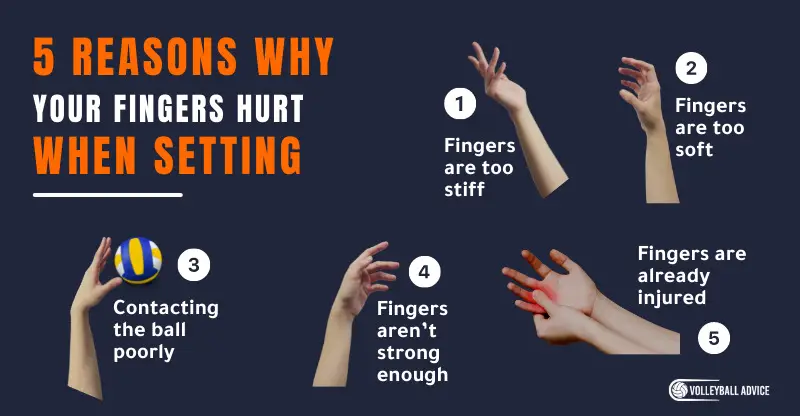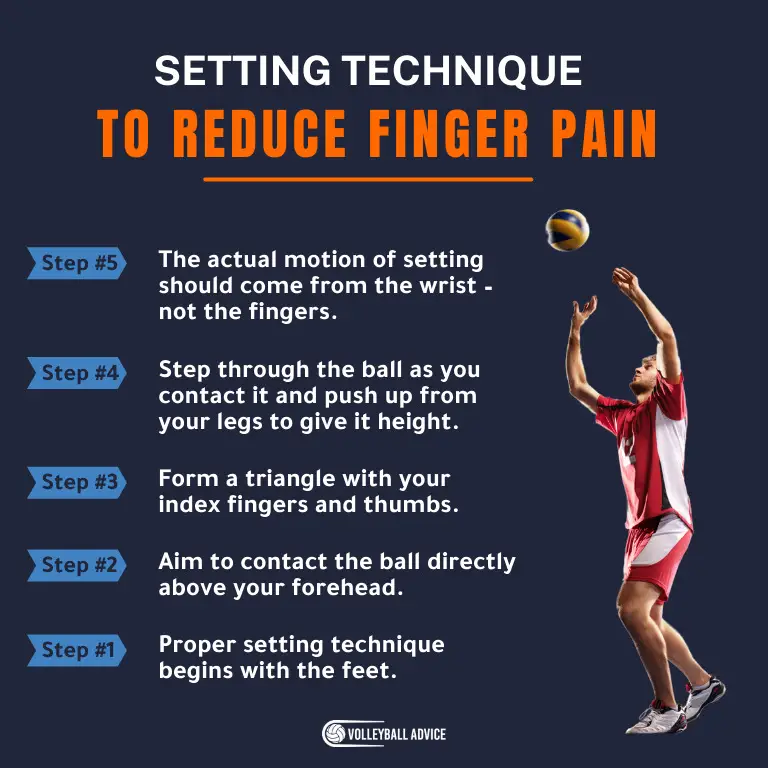How To Set A Volleyball Without Hurting Your Fingers: 5 Tips
Sometimes setting a volleyball can result in finger injuries, jammed thumbs, and overstressed joints, and while this is uncommon it can be extremely painful when it does happen. Today, we’re going to look at why this happens and how to avoid it.
So, how do you set a volleyball without hurting your fingers? To set a volleyball without hurting your fingers, you must practice good technique, which includes “catching” the ball between your index fingers and thumbs and then releasing it from the wrists. You can also lessen finger stress by stretching your fingers often and improving overall hand strength.
Unlike passing – where new players might feel pain until their body gets used to it – setting should result in little to no pain whatsoever. A proper set should feel smooth, unhurried, and almost relaxing to release.
Despite this, players’ fingers might begin to hurt from setting. In this article, I’m going to be breaking down what contributes to finger pain in setting, what proper technique looks like, and some things you can do to mitigate the damage.
5 Reasons Why Your Fingers Hurt When Setting
The 5 reasons your fingers hurt while setting are:
- Fingers are too stiff
- Fingers are too soft
- Contacting the ball poorly
- Fingers aren’t strong enough
- Fingers are already injured
Remember, setting according to any of the five reasons above is incorrect form and will likely result in you losing points in a match. For both your health and the success of your team, work on fixing the problem by diagnosing exactly which one of the reasons below applies to you.
1. Fingers Are Too Stiff
Stiff fingers while setting are usually good, but if your fingers aren’t conforming to the ball then it is creating stress.
This happens because by locking your finger joints and applying stress at an angle – the ball in this case – and your fingers can quickly become fatigued and sore from the impacts.
As a general rule, try to catch the ball with soft fingers and release with stiff fingers. This will make your sets quieter, more accurate, and should eliminate finger pain.
2. Fingers Are Too Soft
This is the exact opposite of number one, but is also a potential contributing factor to finger pain.
Soft fingers are good for contacting the ball smoothly as they won’t jostle it, but releasing the ball with soft fingers may cause them to twist or overextend to get the control that stiff fingers naturally provide.
Experiment with finger stiffness until you find a comfortable position to set from. Practice might seem tiresome, but once you figure it out, setting will be much easier.
3. Contacting the Ball Poorly
Once you’ve figured out your finger positions, it’s time to consider your hand placement.
This category is very general, but if you’re setting from anywhere that is not directly above your forehead with your hands angled anywhere except 45 degrees towards each other, then you are contacting the ball poorly.
This is one of the more dangerous reasons, because while this can hurt your fingers the bigger danger is that you can twist a joint or pull a muscle; elbows are the usual suspects here.
4. Fingers Aren’t Strong Enough
If you’re doing everything right and your fingers still hurt, it might just be because they’re not used to setting yet.
This should feel like more of an ache than a pain though, and will disappear with time.
We’ll discuss some ways to help strengthen your fingers later on, so skip ahead if this sounds like you.
5. Fingers Are Already Injured
This one might seem obvious, but it bears repeating.
If your fingers hurt when setting, it might be because of a previous injury. Cuts, bruises, finger sprains, and broken bones all make setting very unpleasant and painful.
The best course of action here is to avoid setting altogether until your injury has healed.
Ask your coach or physical trainer to confirm when you can start setting again, and how much practice you can still participate in.
If you absolutely need to keep setting while you have a finger injury, tape your fingers like this:
Related Article: How To Play Volleyball Without Hurting Your Arms (11 Tips)
Setting Technique To Reduce Finger Pain
Volleyball is a game of fractured seconds and momentary touches on the ball. As a sport that relies so much on precision for so little contact, technique will always be king for setters.
Step #1: Proper setting technique begins with the feet.
Quickly assess where the ball is going to land and move to stand directly beneath it. Ideally, you want to have completed this step before the ball has reached the top of its arc.
Step #2: Aim to contact the ball directly above your forehead.
A drill coaches often use is the “spot check”: if you don’t set the ball, it should land squarely on your forehead and bounce the direction you’re looking. This positioning of feet and body will give you the best chance to set where you want every time.
Step #3: Form a triangle with your index fingers and thumbs.
These should form a cradle that “catches” the ball before shooting it out again; remember, catch softly, release stiffly. Your three remaining fingers on each hand should be used for ball support only and also form a cradle. However, the main point of contact will always be your index fingers and thumbs.
Step #4: Step through the ball as you contact it and push up from your legs to give it height.
Try to step forward with the leg closest to the net, as this will prevent you mentally and physically from setting it too close to the net or over by accident.
Step #5: The actual motion of setting should come from the wrist – not the fingers.
Snap your wrist up and out at the moment of contact, keeping the motion smooth and unhurried. Jerky motions will result in a double touch, costing you the point.Keep your arms high and elbows out as you practice, and find a comfortable position that works for you.
Key Takeaway If you experience any finger pain, refer to the previous section and go through the list, staying mindful of what you’re doing. Done properly, this will give you fantastic setting technique.
Check out this guide: Hand Position For Setting In Volleyball (7 Steps)
3 Drills To Strengthen Fingers For Setting
Strengthening your fingers is never a bad idea for volleyball players, and will definitely help prevent discomfort if you’re suffering finger pain from setting.
Here are 3 drills to practice:
- Wall Sets
- Finger Pushups
- Grip Trainer
Wall Sets
One of my first coaches used to tell me: “A wall and a ball are your best friend.”
He believed in this so much that the words are now engraved into a wall that was built to honor his legacy.
All you need to improve is a ball and a wall. Practice setting against the wall, then move back and forth, or from side to side, making it more difficult as you improve.
If you want an additional challenge, use a different kind of ball, such as a basketball, or even take advantage of medicine balls to practice with if your gym provides them.
Check out more volleyball drills in our Ultimate Volleyball Drill Guide.
Finger Pushups
These are a great spin on traditional push-ups that will help strengthen your fingers.
Start at an incline – against a wall or desk – and work your way up to doing them on the floor.
You can also change this up by doing finger planks to help your core strength as well. Be creative and find a level of difficulty that works for you.
Grip Trainer
Grip trainers are awesome and have been used by basketball players for years to help their ball handling and control. They are also a great investment for a serious volleyball player.
The device is essentially a spring with two handles that you push together in your palm at varying levels of difficulty. This increases both your finger dexterity and finger strength, and has the added benefit of improving your block.
The best grip trainer is called the “Captain of Crush Grippers”, which come in different sizes.
Here’s what I suggest:
- For men, I would get three sizes: Trainer, 0.5, and 1.0.
- For women, or those who have never trained their finger strength before, I would get two sizes: Guide and Sport.
As you get stronger, you can add more sizes to your arsenal.
Whether you use it for 30 minutes a day while watching Netflix or incorporate it into your regular gym session, it’s a great tool to have. Definitely recommended.
Click HERE to check out the Captain of Crush Grippers on Amazon.
Finger Pain In Volleyball: Injury Prevention and Recovery
Now begins a useful section for anyone who came here looking for help.
The best recovery method I’ve found for sore fingers – both from blocking and setting – is to ice them and alternate between hot and cold. Do not ice for longer than 15 or 20 minutes, as this can start to negatively affect your body.
Ice, wait an hour, then apply heat. Repeat as often as necessary.
For cold, I like to hold ice packs since I can wrap my fingers around them – just remember to ice the back of your fingers too. As for heat, I use a hot water bottle, which I think we can all agree is just a nice experience anyway.
However, if I’ve said it once, I’ve said it a million times:
Prevention is always better than cure.
The best way to avoid recovering from sore fingers is to not injure them in the first place. Use tape to strengthen your joints or to bind two fingers together, and remember to stretch before every practice.
Finger stretches (forward/back) should be the bare minimum, and mix up your setting for warmups low-high-low until ready to go.
Here’s one of my favorite stretching series to do:
Used together with your finger strengthening exercises, you should have no problem setting, and your finger pain should become non-existent.
Final Thoughts: What Happens If The Pain Persists?
If the pain persists, the first step is to talk to your coach or physical trainer and ask them for help. Even if they make you sit out one match, it will be a better solution than continuing to damage your body.
If you’ve followed the guidelines in this article and given yourself time to heal but it still hurts when setting, seek medical attention.
It’s extremely likely that your pain isn’t from setting at all at this point, it’s just the thing that’s triggering it.
Setting Resources
Check out our other resources:
- Types of Sets In Volleyball: 18 Types Explained + How To Use
- 4 Keys To Being The Best Setter You Can Be
- The Setter Volleyball Position: 5 Marks of A Great Player
- Volleyball Positions, Roles, & Formations (Complete Guide)
- Footwork For Setting A Volleyball: Technique, Drills, Errors
- How To Set a Volleyball Without Noise (8 Tips)
About The Author
Ailan Samuel is a writer and athlete who has played volleyball at the university, club, and national level since 2012. He has competed successfully in both beach and indoor competitions, resulting in four silver and two gold medals, and was awarded the Half-Blue while playing in Scotland. He received his MA in English and Medieval History from the University of St Andrews, Scotland, and is currently studying for his MA in Publishing and Creative Writing at Bournemouth University.



